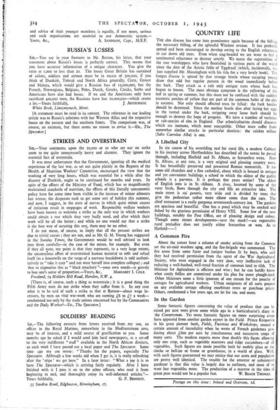COUNTRY L IFE
THE elm disease has come into prominence again because of the felling, the necessary felling, of the splendid Windsor avenue. It has probably spread and been encouraged to develop owing to the English reluctance to cut down old trees. Even when stag-headed we are wont to feel a sentimental reluctance to destroy utterly. We nurse the superstition of the tree worshippers who have flourished in various parts of the world since the date of the Asiatic fable of Yggdrasil (which, incidentally, hi, just supplied Mr. Massingham with his title for a very lovely book). The fungus disease is spread by that strange beetle whose escaping young draw that odd but regular pattern in the wood immediately below the bark. They attack as a rule only antique trees whose bark has begun to loosen. The most obvious symptom is the yellowing of the leaf in spring or summer, but this must not be confused with the sudden eccentric patches of yellow that are part of the common habit of the elm in autumn. Not only should affected trees be felled : the bark beetles should be destroyed. Since the mother beetle dies after laying her eggs in the tunnel under the bark, stripping away loose bark should be enough to destroy the hope of progeny. We have a number of varieties or sub-species of elm in England. Our arboriculturists should discover which are immune, which most susceptible. Other trees suffer from somewhat similar attacks in particular districts: the cricket willow (Salix Caerulea Alba) is one.
A Libelled City In the course of his overriding zeal for rural life, a modern Cobbett in his journey across Hertfordshire has described all the towns he passed through, including Hatfield and St. Albans, as featureless wens. Now St. Albans, at any rate, is a very original and pleasing country town, It has beautifully preserved and presented Roman memorials. It his some old churches and a fine cathedral, about which is housed in antique and yet convenient buildings a school to which the oldest of the public schools is a parvenu. It is perhaps 600 years senior! The oldest of English inns is in St. -Albans. A river, haunted by some of the rarer birds, flows through the city and fills an attractive lake. The main street is sui generis, very wide and is divided by trees that give the pedestrian rather more elbow room than the cars. The chief restaurant is a really gorgeous seventeenth-century inn. The gardens are spacious and beautiful. One has a pond which may be stocked and fished by the gracious permission of Henry VIII. Some few of the new buildings, notably the Post Office, are of pleasing design and colour. Though some recent developments—save the mark!—are regrettable rural prejudice does not justify either featureless or wen. As to Hatfield—!
A Common Fire
About the sunset hour a column of smoke arising from the Common set the air-raid wardens agog, and the fire-brigade was summoned. The fire arose from some furze and juniper bushes lit by boys, who said they had received permission from the agent of the War Agricultural Society, who were engaged in the very slow, very ineffective task of reducing a well-bushed, well-treed fraction of common land to tilth. The Minister for Agriculture is efficient and wise ; but he can hatdly know what costly follies are committed under his Plea for more plough-land. Other Ministers seem a little ignorant of one reason for the paucity of cottages for agricultural workers. Urban emigrants of all sorts pounce on any available cottage offering exorbitant rents or purchase prices. Others, condemned a few years ago, are let for los. and more.
In the Garden Some fantastic figures concerning the value of produce that can be raised per acre were given some while ago in a horticulturist's diary in the Countryman. , Yet more fantastic figures on more surprising crops have appeared from another garden expert in the Field. Prince Kropotkin in his great pioneer book, Fields, Factories and Workshops, roused a certain amount of incredulity when he wrote of French gardeners pro- ducing about L600 per acre by simultaneous and successive crops of many sorts. The modern experts more than double this figure allowing only one crop, such as vegetable marrows and ridge cucumbers—of all vegetables. Such figures are made possible both by mobile glass or the cloche or bell-jar or frame or greenhouse, in a world of glass. Well. with such figures guaranteed we may rejoice that our acres and population are pretty well identical. The trouble for the amateur or subsistence gardener is that this value is largely due to earliness, and most of us want late vegetables more. The production of a marrow in the time of
Postage on this issue : Inland and Overseas, id.


























 Previous page
Previous page